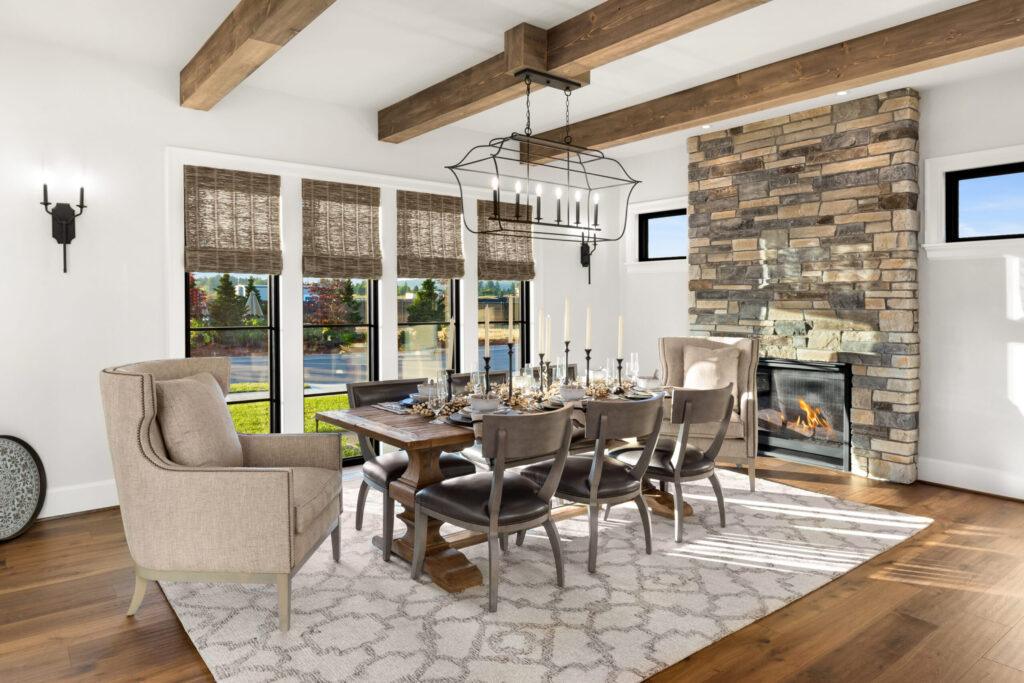Exterior faux rock panels are a clever solution for getting the high-end look of natural stone without the hefty price tag or back-breaking weight. They give homeowners a realistic way to seriously boost their home's curb appeal, blending authentic textures with surprising affordability and straightforward installation.
The Secret to a High-End Exterior Renovation
Picture pulling up to your home and seeing a stunning stone exterior that looks like it cost a fortune. For most of us, that dream feels a bit out of reach. The eye-watering cost, immense weight, and complex installation of real stone can quickly turn an exciting renovation plan into a logistical and financial nightmare.
This is where modern materials step in to change the game. Exterior faux rock panels are engineered to bridge that gap between aspiration and reality. They deliver the genuine, textured beauty of stone because they're often cast from moulds of the real thing, but they're made from lightweight, durable materials. This means you can get that sought-after, high-end look without having to reinforce your home's structure or hire a team of specialised masons.
Achieving the Dream Without the Drawbacks
Think of it as having your cake and eating it too. You get the timeless elegance and curb appeal of a stone-clad home, which can add real value to your property. At the same time, you completely sidestep the challenges that make natural stone a non-starter for so many budgets and timelines.
The advantages are pretty clear:
- Affordability: The cost for both the panels and the labour is significantly lower than for quarried stone.
- Ease of Installation: Because the panels are so light, a DIY-savvy homeowner or a general contractor can often handle the job, cutting project time down from weeks to just a few days.
- Versatility: You can apply these panels to almost any surface—foundation walls, columns, or even the entire front of your house—without needing major structural changes.
It’s this powerful combination of great looks and practicality that has made faux stone a go-to choice for renovators all over the world.
A Growing Global Trend
The appeal of exterior faux rock panels isn't just a local phenomenon. In Turkey, for example, the booming construction and renovation markets have led to a steady rise in their use. Their lighter weight, simpler installation, and lower costs make them especially well-suited for urban development projects in bustling cities like Istanbul, Ankara, and Izmir. In fact, industry reports show that synthetic stone products are carving out an ever-larger slice of the Turkish stone market. To get a bigger picture, you can explore more about the growing global siding market and see just how much of an impact these materials are making.
The whole idea behind faux stone is simple: deliver the visual punch of natural rock with the performance and accessibility of modern engineering. It’s about making sophisticated design achievable for everyone.
In the end, whether you're planning a complete exterior overhaul or just a small accent project, these panels offer a practical way to transform your home. They’re proof that you don't need a bottomless budget to create a home that turns heads and makes you proud every time you pull into the driveway.
What Gives Faux Rock Panels Their Realistic Look?
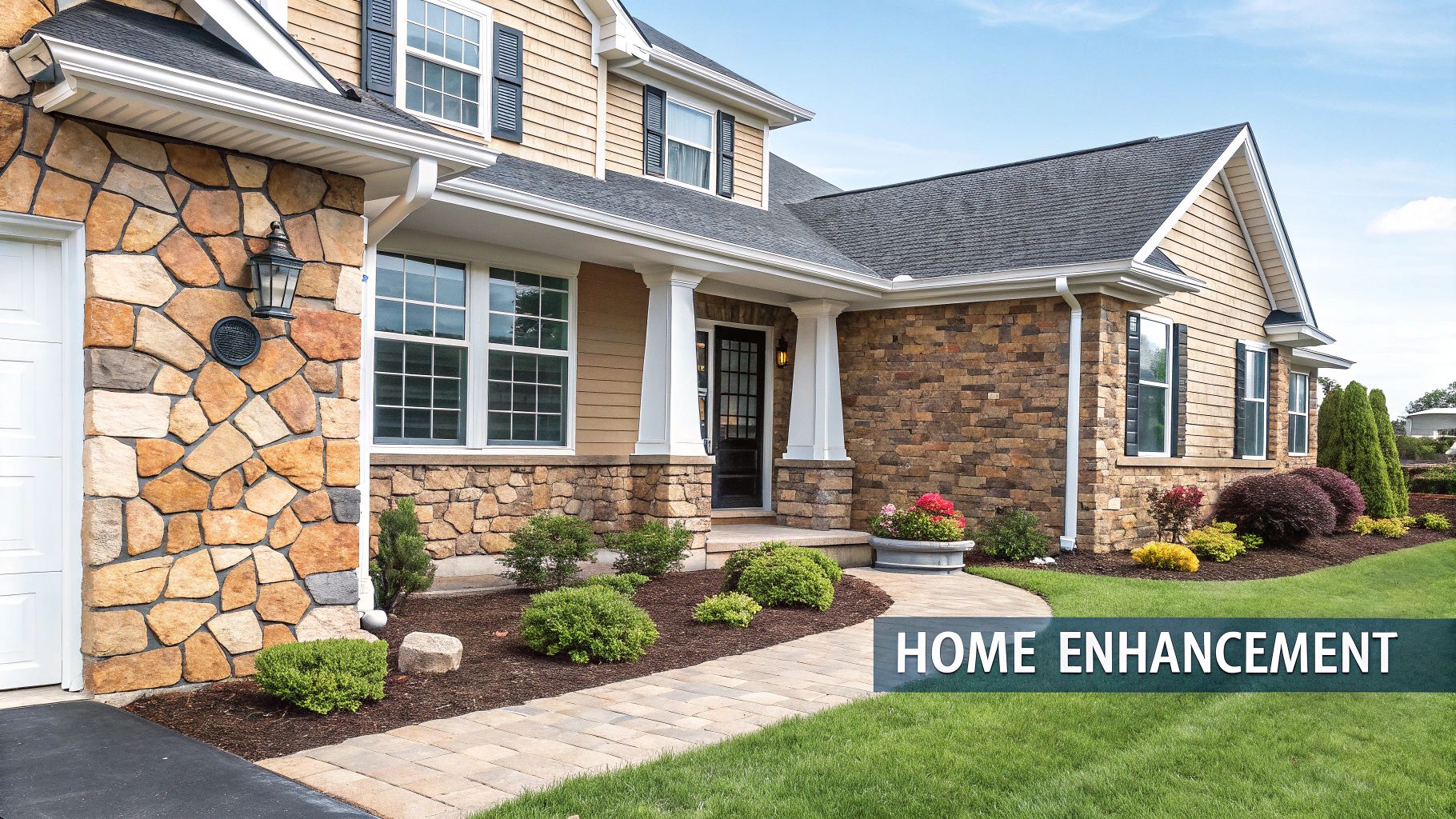
Let's be honest, the word ‘faux’ can sometimes bring to mind cheap imitations. But when we're talking about today's exterior rock panels, that assumption couldn't be more wrong. The incredible realism you see isn't magic; it's the product of smart engineering and an artistic manufacturing process that honours every detail of natural stone.
The secret starts with the core material. High-end panels are typically made from high-density polyurethane, a seriously tough and adaptable polymer. It’s a world away from simple plastic, chosen for its incredible resilience against the elements. A key benefit is that it doesn’t absorb moisture, which means it won't crack during those harsh freeze-thaw cycles that can spell disaster for some natural stones.
This durable foundation is the perfect canvas, but the real magic happens in how that canvas is shaped and coloured.
Capturing Nature’s Blueprint
To get a convincing look, you have to start with a perfect blueprint. Manufacturers don't just sketch a "rocky" pattern; they go right to the source. They hand-pick real stones, chosen specifically for their interesting textures, shapes, and unique character. From these genuine rocks, they create detailed casts.
This method captures every tiny crevice, fissure, and rugged edge. When the polyurethane is poured into these moulds, it takes on the exact, authentic surface of quarried stone.
The entire point is to make a product so realistic that even a trained eye would have a hard time telling it apart from the real thing. This dedication means the patterns are organic and don't repeat, sidestepping that artificial look you might see in older, less sophisticated products.
The result is a panel with all the depth and complexity of a true stone wall, laying the groundwork for a stunningly believable finish.
The Art of Multi-Layered Colouring
A great texture is only half the story. Authentic colour is just as vital. A flat, single coat of paint would be an instant giveaway, which is why the best manufacturers employ a complex, multi-layered finishing process. This is how they achieve the rich, varied tones you see in nature.
The process usually involves several colouring stages, often applied by hand. Each new layer adds depth, brings out highlights, and creates shadows, resulting in the beautiful, non-uniform look that makes genuine stone so appealing.
Here’s a glimpse into how it’s done:
- Base Coat: It all begins with a base colour that establishes the panel's overall personality, whether it's a cool slate grey or a warm, earthy beige.
- Layered Accents: Artists then add secondary and even tertiary colours. This is what highlights specific features in the rock texture, mimicking everything from mineral deposits to natural weathering over time.
- Protective Finish: The final touch is a clear, UV-resistant coating. This not only shields the vibrant colours from fading in the sun but also adds a subtle sheen that makes the texture pop.
This meticulous, step-by-step colouring ensures no two panels look identical, reinforcing the natural, random appearance of a true stone installation. If you're weighing your options, exploring a gallery of exterior wall stone finishes can give you a real sense of the possibilities. It's this commitment to craftsmanship that allows faux rock panels to boost a home's curb appeal with authentic, lasting style.
The Real-World Benefits of Faux Stone Cladding
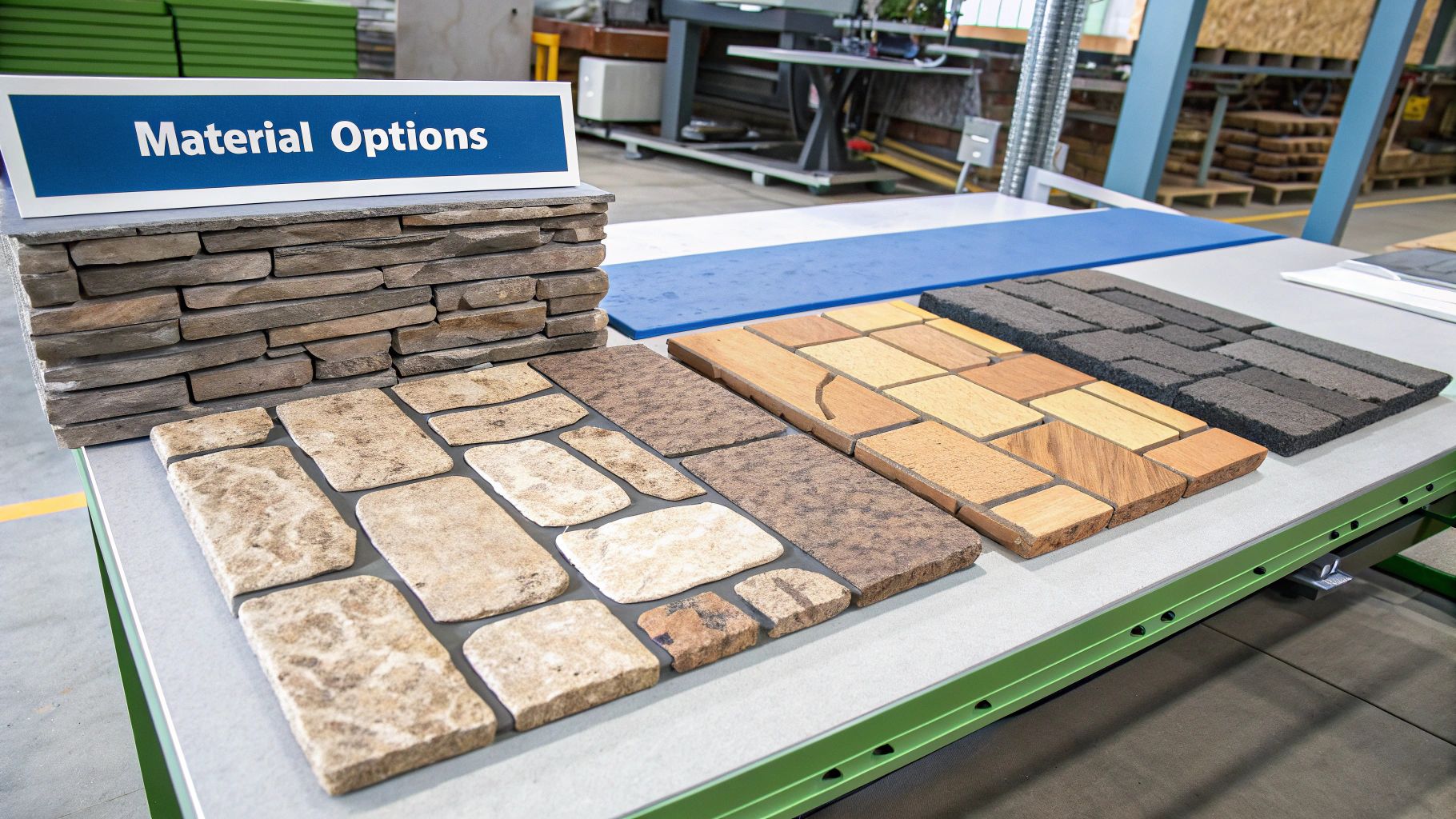
Sure, exterior faux rock panels look incredibly realistic, but their real magic lies in the practical advantages they bring to the table. We’re talking about benefits that go well beyond looks, directly impacting your wallet, your project schedule, and the long-term health of your home.
When you opt for faux stone, you're not just making a design choice. It’s a smart, strategic move. The most obvious win is the cost. Natural stone is pricey to buy, and that's before you even factor in the specialised (and expensive) mason needed to install it. Labour costs alone can send a budget spiralling.
And then there's the weight. Real stone is heavy. So heavy, in fact, that it often demands extra structural support or a concrete ledge built into the foundation—adding yet another layer of cost and complexity. Faux rock panels neatly sidestep all of these issues, saving you a small fortune on materials, specialised labour, and foundational work.
Transform Your Home in a Weekend
Another massive advantage is the installation speed. A traditional stone masonry job can drag on for weeks, turning your garden into a prolonged construction site. By contrast, exterior faux rock panels can often be fitted in just a single weekend. It’s a complete game-changer.
Think about it this way: a contractor saves their client thousands on a project. This isn't some fantasy scenario; it happens all the time. By choosing faux panels, the client gets the exact stone finish they wanted in a fraction of the time, freeing up a huge chunk of their budget. That extra cash can then be put towards things like upgraded landscaping or new outdoor lighting, creating a far more polished and complete transformation.
"The ability to achieve the look of a full masonry job without the associated costs or extended timeline is a powerful advantage. It allows homeowners to allocate resources to other parts of their renovation, achieving a higher-end result overall."
This speed is all down to the panels' lightweight construction and clever, user-friendly interlocking designs. It makes ambitious home makeovers feel genuinely achievable, whether you're a keen DIYer or hiring a general contractor.
Superior Performance and Durability
While saving time and money is great, the long-term performance is what really provides peace of mind. High-quality faux stone is engineered to outperform many traditional materials where it counts.
- Moisture Resistance: Natural stone can be porous, soaking up water and leading to cracks or spalling when it freezes and thaws. High-density polyurethane panels, however, are completely non-porous. This built-in resistance stops moisture damage, mould, and mildew in its tracks.
- Pest Resistance: Materials like wood are a tempting meal for termites and other pests. Faux stone, made from inorganic composites, is totally unappetising to any destructive insects.
- Added Insulation: The polyurethane that these panels are made from adds an extra layer of thermal insulation to your home. This can help improve your home's energy efficiency, potentially lowering your heating and cooling bills over time.
Modern advancements have only amplified these perks. In Turkey’s demanding construction sector, for example, the latest faux rock panels can cut installation time by as much as 40% compared to natural stone. This drastically reduces labour costs and gets projects over the finish line faster. With a growing focus on energy-efficient homes, these lightweight, insulating panels are quickly becoming a go-to solution. You can read more about the rising popularity of low-maintenance siding in industry reports on Truexterior.com.
This built-in resilience makes them a sound choice for virtually any climate, ensuring your home's exterior looks fantastic for years with very little effort. For homeowners weighing their options, our guide on thin stone wall cladding for an exterior transformation offers more detail on modern cladding solutions. Ultimately, choosing faux rock is a decision that pays you back in savings, durability, and lasting kerb appeal.
Design Inspiration for Your Home Exterior
Knowing the technical perks of exterior faux rock panels is one thing, but truly appreciating their power to transform a home is something else entirely. This is where the practical details meet pure creativity. Faux stone isn't just another building material; it's a design tool that can completely reshape your home's character, turning ordinary surfaces into eye-catching architectural features. The secret is to think beyond just covering walls and start exploring the clever ways these panels can make a real statement.
Take your home's entryway, for instance. Instead of the usual plaster or siding, imagine a striking accent wall finished in a rugged Ledgestone style. The deep shadows and varied profile create an immediate feeling of quality and substance, offering a bold welcome to your guests. Just this one change can lift the whole front of your house, making the entrance feel grander and more deliberate.
Creating Specific Architectural Accents
The real magic of exterior faux rock panels is how strategically they can be used. You don't have to clad the entire house to make a huge visual difference. By zeroing in on specific architectural elements, you can inject texture, personality, and a serious boost in perceived value.
It's all about high-impact applications:
- Foundation Cladding: Wrapping a plain concrete foundation in a Fieldstone style instantly grounds the house. It gives it a timeless, rustic base that feels like it's always been there.
- Column Wraps: You can turn those boring support posts on your porch into impressive stone pillars. It’s a relatively small job that pays off massively in visual appeal.
- Wainscoting: Applying stone panels to the lower third of your exterior walls creates a classic wainscoting look, adding a sophisticated layer of texture and breaking up flat surfaces.
- Outdoor Living Spaces: A simple patio or deck can become a cosy, resort-like retreat. Cladding a feature wall with a warm River Rock style creates the perfect backdrop for an outdoor kitchen or a comfortable seating area.
Each of these ideas uses faux rock not just as a cover-up, but as a thoughtful design choice to highlight and improve your home's existing structure.
Harmonising Faux Stone with Other Materials
A great exterior design is all about finding the right balance. One of the biggest questions I hear from homeowners is how to make faux stone work with their home's existing materials. The good news is that these panels are incredibly versatile and pair beautifully with almost any finish.
A good rule of thumb is to think in terms of contrast and complement. You want to create a cohesive look where different textures and colours work together, not fight for attention.
For example, a house with smooth, light-coloured stucco looks fantastic with a darker, more rugged stone accent. The contrast in both colour and texture makes each material pop. In the same way, the natural warmth of wood siding can be beautifully enhanced by the earthy tones of a brown or tan faux stone, creating a look that feels unified and inviting.
Here’s a quick guide to pairing different stone styles:
| Existing Material | Recommended Stone Style | Design Goal |
|---|---|---|
| Vinyl Siding | Ledgestone or Stacked Stone in a complementary colour. | To add a focal point of rich texture that breaks up the uniform lines of the siding. |
| Stucco or Plaster | Fieldstone or River Rock with varied shapes. | To introduce an organic, natural element that plays off the smooth, flat surface. |
| Wood or Timber | Any style with warm, earthy tones like browns or reds. | To lean into the natural, rustic character of the wood and create a harmonious feel. |
| Brick | A stone with a simpler profile like Cut Cobblestone. | To complement the brick's pattern without making the facade look too busy or cluttered. |
By carefully choosing the right style and colour of exterior faux rock panels, you can achieve a sophisticated, layered exterior that looks like it was planned by an architect. This thoughtful approach is what elevates a home from simply nice to truly spectacular, opening up a world of stunning possibilities.
Your Guide to Installing Faux Rock Panels
One of the best things about exterior faux rock panels is just how simple they are to install. Forget the specialised skills, heavy machinery, and weeks of messy labour that come with traditional masonry. Faux stone installation is a project that a capable DIYer or any general contractor can tackle with confidence. This accessibility means you can get that high-end, professional look without the usual cost and headache, transforming what could be a major renovation into a manageable weekend project.
The whole process is quite methodical. It’s all about good preparation and taking your time to get the details right, which is what guarantees a seamless, authentic-looking result. Everything begins with the wall itself. Before any panels go up, your surface must be clean, dry, and solid. You’ll need to scrape off any loose paint and clear away any dirt or grime to ensure the panels adhere properly. Most surfaces, like plywood, OSB, or cement board, are ready for direct installation.
Preparing for a Flawless Installation
With a clean surface ready to go, the next step is to plan your layout. This is where you can sidestep common mistakes before they even happen. I always recommend laying a few panels out on the ground first. This lets you get a feel for the pattern and mix up the panels to avoid creating any obvious, repeating sections. A little preview like this goes a long way towards achieving a more natural, organic look.
Accurate measuring and cutting are also crucial. You can use standard woodworking tools, but the real secret is patience. The old rule of "measure twice, cut once" is your best friend here. A great tip for cutting panels to fit around tricky spots like windows, doors, or outlets is to create a cardboard template first. It’s a simple step that can save you from a costly mis-cut.
The image below shows just how easy it is to keep your panels looking fantastic for years after they’re installed.
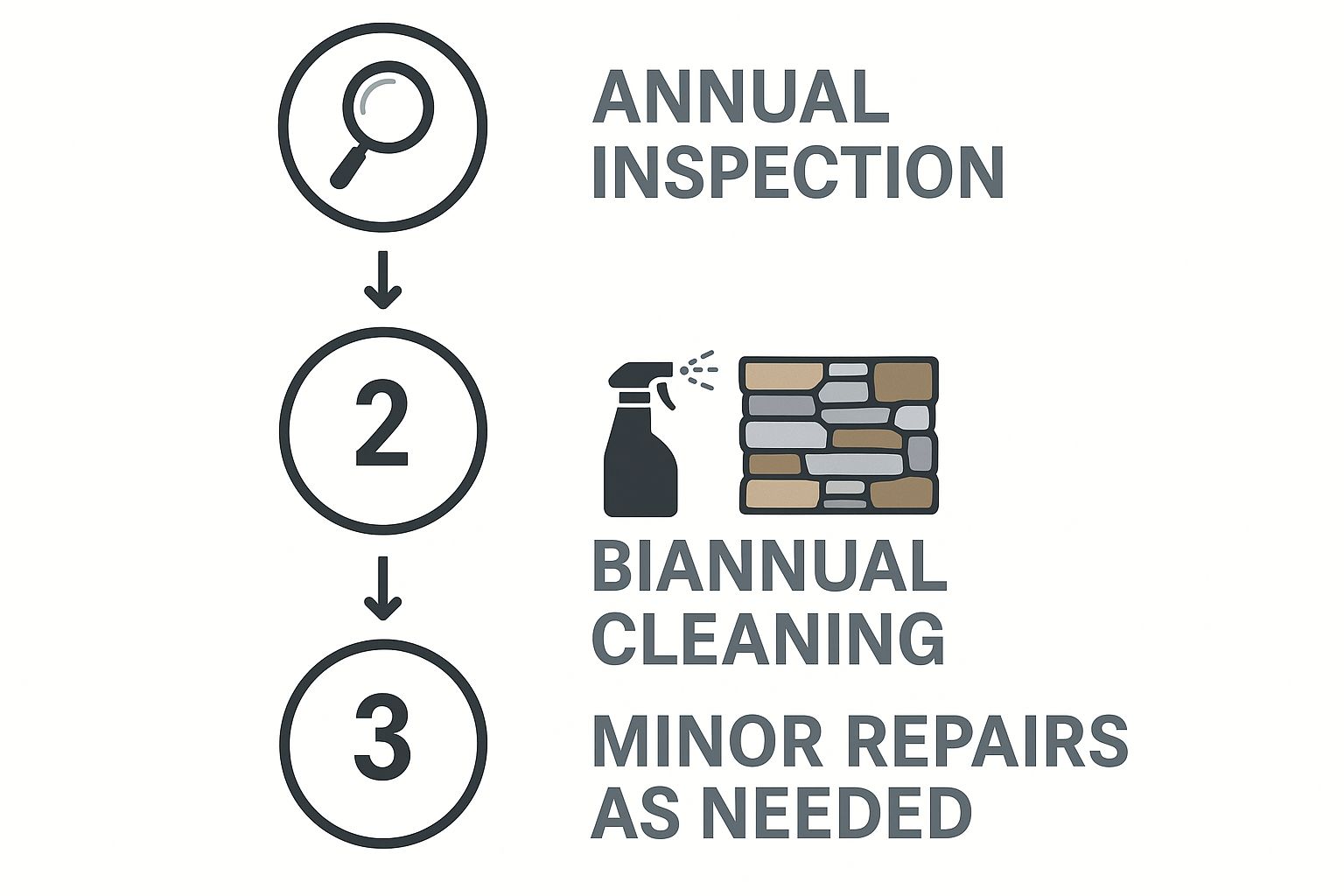
As you can see, maintaining your faux stone exterior is really just a simple cycle of inspecting, cleaning, and occasional touch-ups.
Common Mistakes and How to Avoid Them
Even with a straightforward installation, there are a few common pitfalls that can spoil the final look. Knowing what to watch out for is the key to making sure your project looks like it was done by a pro, not a rushed amateur. The most common giveaway? Visible seams between the panels.
A seamless finish is the hallmark of a quality installation. The goal is for the individual panels to disappear, creating the illusion of a single, continuous stone wall.
To make those seams vanish, you need to ensure the panels are interlocked as tightly as possible. Good quality panel systems are designed with overlapping edges that are made to hide these joints. For any tiny gaps that remain, you can apply a bead of textured, colour-matched caulk and stipple it with a small brush to blend it in perfectly.
Another rookie mistake is poor alignment. Always—and I mean always—use a level to get your first row, or "starter course," perfectly straight. If that first row is even slightly crooked, every row you add on top will be crooked too, and the final result will look messy and unprofessional.
Here are a few more tips for getting that perfect finish:
- Stagger Your Seams: Never line up the vertical seams from one row to the next. Just like with brickwork, you need to stagger them to create a believable, natural pattern.
- Plan for Corners: It's always best to use the pre-made corner pieces from the manufacturer. They’re designed to wrap around corners for a clean, authentic look that’s far superior to trying to mitre two flat panels together.
- Secure Fasteners Correctly: Drive your screws or nails into the designated spots on the panel’s fastening strip. Don’t overdrive them, as this can easily crack the panel or cause it to warp.
It's this attention to detail that really makes the project shine. If you're interested in how these techniques compare to similar materials, our guide on thin stone veneer installation offers some great additional insights. With a bit of patience, anyone can achieve a stunning and durable exterior faux rock panels installation, adding serious value and kerb appeal to their property.
Frequently Asked Questions About Faux Rock Panels
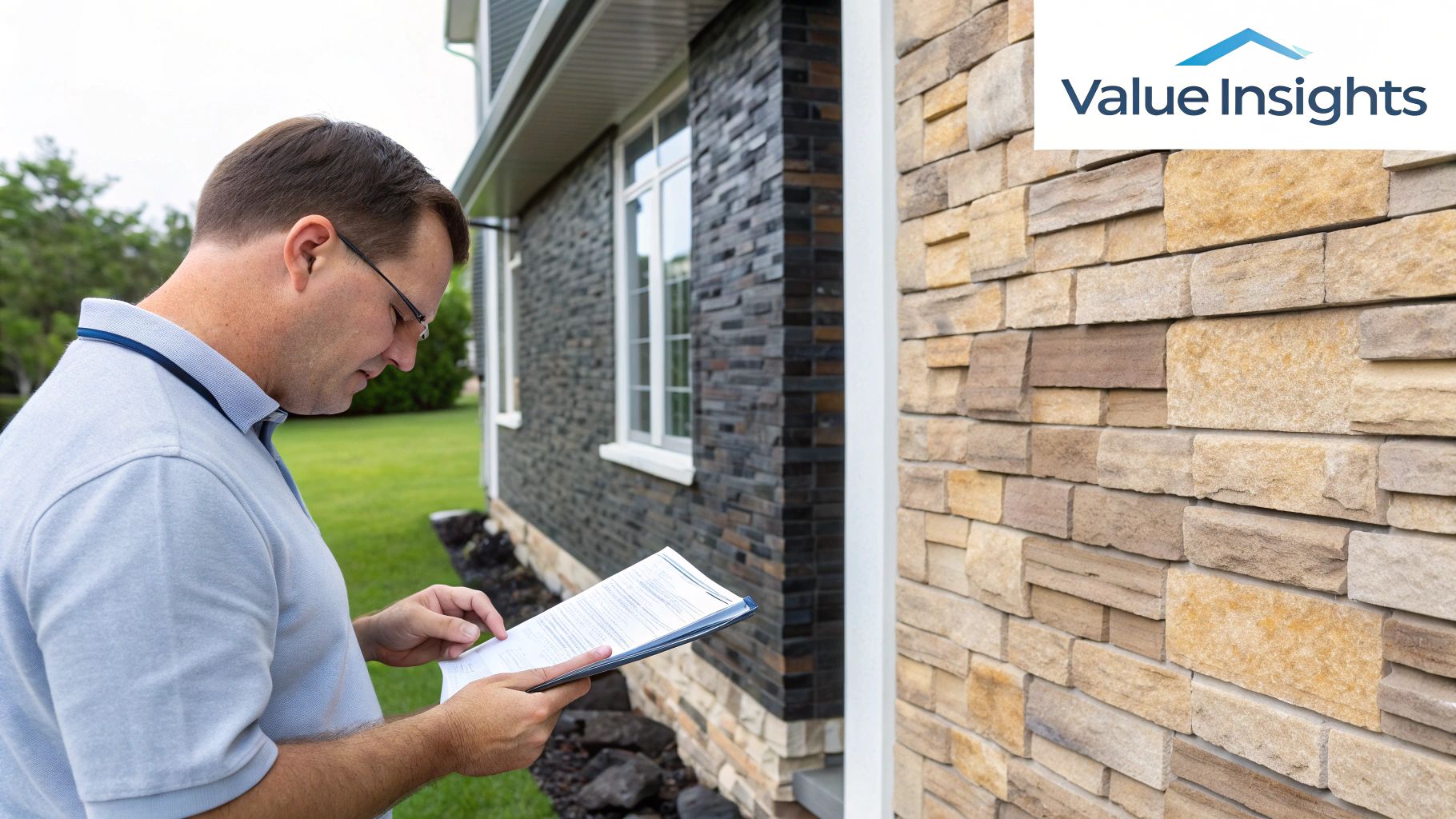
Even after seeing all the benefits, it's completely normal to have a few lingering questions before you dive into a project. To make sure you're confident in your decision, let's tackle some of the most common queries we hear from homeowners about exterior faux rock panels.
We'll cover everything from how they perform in harsh weather and how long they last, to fire safety and day-to-day upkeep. My goal here is to give you the clear, straightforward answers you need to move forward with your renovation feeling fully prepared.
How Do Faux Rock Panels Handle Extreme Weather?
This is a big one, and for good reason. High-quality exterior faux rock panels are built from the ground up to handle whatever nature throws at them. The secret lies in the material – they’re typically made from high-density polyurethane, a closed-cell material that simply doesn’t absorb moisture. This is a game-changer because it prevents the cracking and splitting you often see in porous materials during brutal freeze-thaw cycles.
What about sunny climates? The best panels come with UV inhibitors baked right into the material during manufacturing. Think of it like a powerful, built-in sunscreen that protects the rich, deep colours from fading under constant sun exposure. Reputable brands put their products through gruelling tests to ensure they can stand up to high winds, driving rain, and even everyday bumps and scrapes, making them a reliable choice for just about any region.
Are Faux Stone Panels Hard to Clean?
Not at all. In fact, one of the best things about faux stone is how incredibly low-maintenance it is. Unlike natural stone, which can be porous and might need regular sealing to fend off stains, these polyurethane panels are much simpler to care for.
For most day-to-day dust and dirt, a quick spray with a garden hose is all it takes. If you run into more stubborn grime, a soft-bristled brush and some mild, soapy water will get the job done without any fuss.
A word of caution: steer clear of high-pressure washers and harsh chemical cleaners. They can be too aggressive, potentially stripping the panel's protective finish and damaging the intricate surface texture. Stick to the gentle approach, and you'll preserve both the look and lifespan of your siding.
That simple routine is genuinely all you need to keep your exterior faux rock panels looking as good as the day they were installed.
Can I Paint the Panels to Change the Colour Later?
Yes, you can, and this is a fantastic feature that adds a lot of long-term value. Being able to paint high-quality polyurethane panels means you’re not locked into one colour forever. Your style can evolve, and your home’s exterior can easily change with it, all without needing to replace the panels.
The trick to a professional, lasting finish is all in the prep work.
- Clean Thoroughly: Start by giving the panels a complete clean to get rid of any dirt, pollen, or general grime.
- Use a Quality Primer: Next, apply a high-adhesion acrylic or latex primer designed for plastics or composite materials.
- Apply Exterior Paint: Finish with two coats of a premium exterior-grade latex paint. This ensures the best durability and colour retention.
Following these steps gives you the freedom to refresh your home's appearance whenever you feel it's time for a change.
What Is the Fire Rating of Most Faux Rock Panels?
Safety is non-negotiable when it comes to building materials. The good news is that most reputable manufacturers offer panels with a Class A fire rating, which is the highest and most stringent classification available. This rating is achieved by treating the polyurethane with fire-retardant agents during the manufacturing process.
A Class A rating means the material is extremely resistant to flame spread, offering a critical layer of protection and, just as importantly, peace of mind for you and your family. Before buying, always double-check the manufacturer’s product specifications to confirm the fire rating.
Ready to transform your home with a stylish, durable, and low-maintenance stone finish? Explore the premium stone veneer solutions at Flomary. Our advanced, lightweight systems deliver the authentic beauty of natural stone with unparalleled ease of installation.
Discover the Flomary collection and start your project today



